MySql update锁定范围
huan1993的技术分享 人气:01、背景
在项目中,我们经常使用到update语句,那么update语句会锁定表中的那些记录呢?此处我们通过一些简单的案例来模拟下。此处是我自己的一个理解,如果那个地方理解错了,欢迎指出
2、前置知识
2.1 数据库的隔离级别
mysql> show variables like 'transaction_isolation'; +-----------------------+-----------------+ | Variable_name | Value | +-----------------------+-----------------+ | transaction_isolation | REPEATABLE-READ | +-----------------------+-----------------+ 1 row in set (0.00 sec)
2.2 数据库版本
mysql> select version(); +-----------+ | version() | +-----------+ | 8.0.28 | +-----------+ 1 row in set (0.00 sec)
2.3 数据库的存储引擎
mysql> show variables like '%storage_engine%'; +---------------------------------+-----------+ | Variable_name | Value | +---------------------------------+-----------+ | default_storage_engine | InnoDB | | default_tmp_storage_engine | InnoDB | | disabled_storage_engines | | | internal_tmp_mem_storage_engine | TempTable | +---------------------------------+-----------+ 4 rows in set (0.01 sec)
2.4 锁是加在记录上还是索引上
锁是加在索引上,那如果表中没有建立索引,是否就是加在表上的呢?其实不是,也是加在索引的,会存在一个默认的。
Record locks always lock index records, even if a table is defined with no indexes. For such cases, InnoDB creates a hidden clustered index and uses this index for record locking
参考链接: https://dev.mysql.com/doc/refman/8.0/en/innodb-locking.html
2.5 update...where加锁的基本单位是
UPDATE ... WHERE ... sets an exclusive next-key lock on every record the search encounters
此处可以理解加锁的单位是: next-key锁
2.6 行级锁
2.6.1 Record Locks
记录锁,即只会锁定一条记录。其实是锁定这条记录的索引。
A record lock is a lock on an index record. For example, SELECT c1 FROM t WHERE c1 = 10 FOR UPDATE; prevents any other transaction from inserting, updating, or deleting rows where the value of t.c1 is 10.
2.6.2 Gap Locks
间隙锁,间隙锁是在索引记录之间的间隙上的锁,即锁定一个区间。前开后开区间,不包括记录本身。
间隙锁如果是使用单列唯一索引值进行更新的话,是会退化成Record Lock。
间隙锁的目的:
- 防止新的数据插入到间隙中
- 防止已经存在的数据被更新到间隙中。
Gap locking is not needed for statements that lock rows using a unique index to search > for a unique row. (This does not include the case that the search condition includes only > some columns of a multiple-column unique index; in that case, gap locking does occur.)
2.6.3 Next-Key Locks
Next-Key Lock 是索引记录上的记录锁和索引记录之前的间隙上的间隙锁的组合。也是锁定一个区间,前开后闭区间。包括记录本身。
如果索引值包括 1,5,10,30,那么next key 锁可能涵盖如下区间
(negative infinity, 1] (1, 115 (5, 10] (10, 30] (30, positive infinity)
negative infinity指的是负无穷。positive infinity指的是正无穷。
2.6.4 测试锁表的表结构
create table test_record_lock
(
id int not null comment '主键',
age int null comment '年龄,普通索引',
name varchar(10) null comment '姓名,无索引',
constraint test_record_lock_pk
primary key (id)
)
comment '测试记录锁';
create index test_record_lock_age_index
on test_record_lock (age);
2.6.5 表中的测试数据
mysql> select * from test_record_lock; +----+------+--------+ | id | age | name | +----+------+--------+ | 1 | 10 | 张三 | | 5 | 20 | 李四 | | 8 | 25 | 王五 | +----+------+--------+ 3 rows in set (0.00 sec)
2.7 查看数据库中当前的锁
select * from performance_schema.data_locks;
字段解释:
| 字段 | 值 | 解释 |
|---|---|---|
lock_type | TABLE | 锁是加在表上 |
| RECORD | 锁加在记录上 | |
lock_mode | IX | 意向排他锁 |
| X或者S | next-key lock 锁定记录本身和记录之前的间隙 | |
| X,REC_NOT_GAP | Record Lock 只锁记录自身 | |
| S,REC_NOT_GAP | Record Lock 只锁记录自身 | |
| X,GAP | gap lock | |
| X,INSERT_INTENTION | 插入意向锁 | |
lock_data | 具体的某个数字 | 表示主键的值 |
| 值,值 | 第一个值:普通索引的值 第二个值:主键值 |
疑问:X,GAP是否可以理解成X锁退化成了GAP锁。
3、测试数据加锁
3.1 唯一索引测试
此处适用单个字段的唯一索引,不适合多个字段的唯一索引
3.1.1 等值更新-记录存在
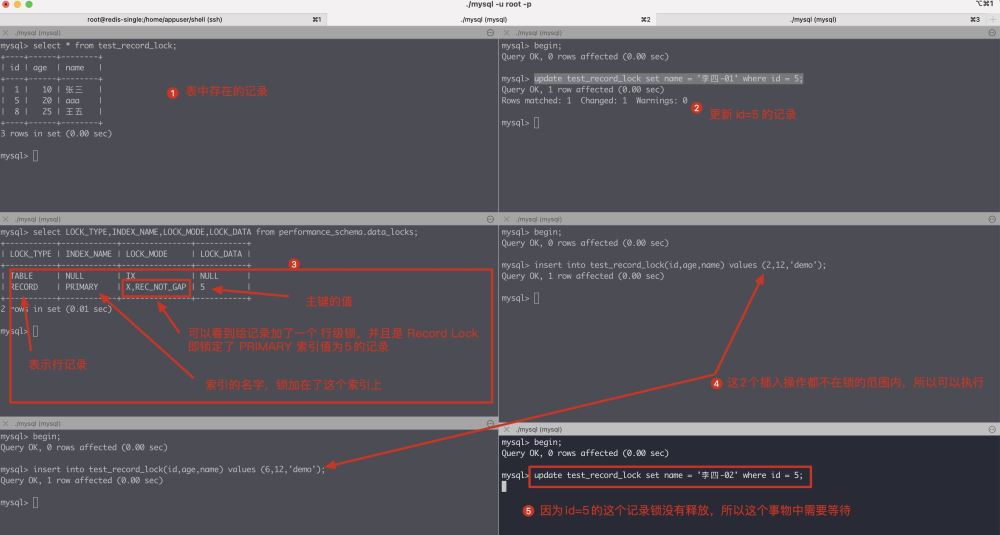
解释:
加next-key lock,那么锁定的记录范围为 (1,5]。
因为是唯一索引,且查询的值存在,next-key lock退化成record lock,即最终只锁定了id=5的这一行数据。其余的数据不影响。
3.1.2 等值查询-记录不存在-01
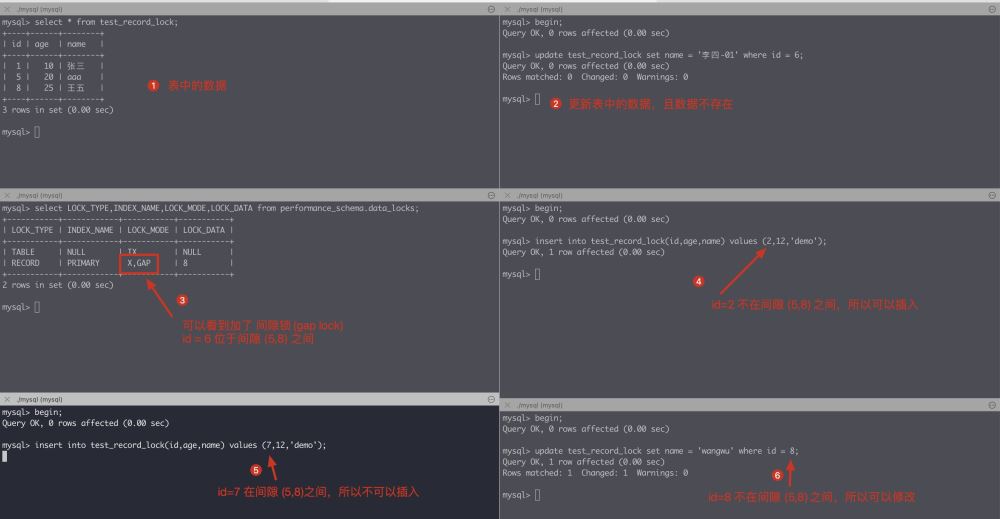
解释:
- 加next-key lock,那么锁定的记录范围为 (5,8]。
- 因为是唯一索引,且查询的值不存在,next-key lock退化成gap,即最终锁定的数据范围为(5,8)。其余的数据不影响。
3.1.3 等值更新-记录不存在-02

3.1.4 范围更新
1、小于或等于最大临界值
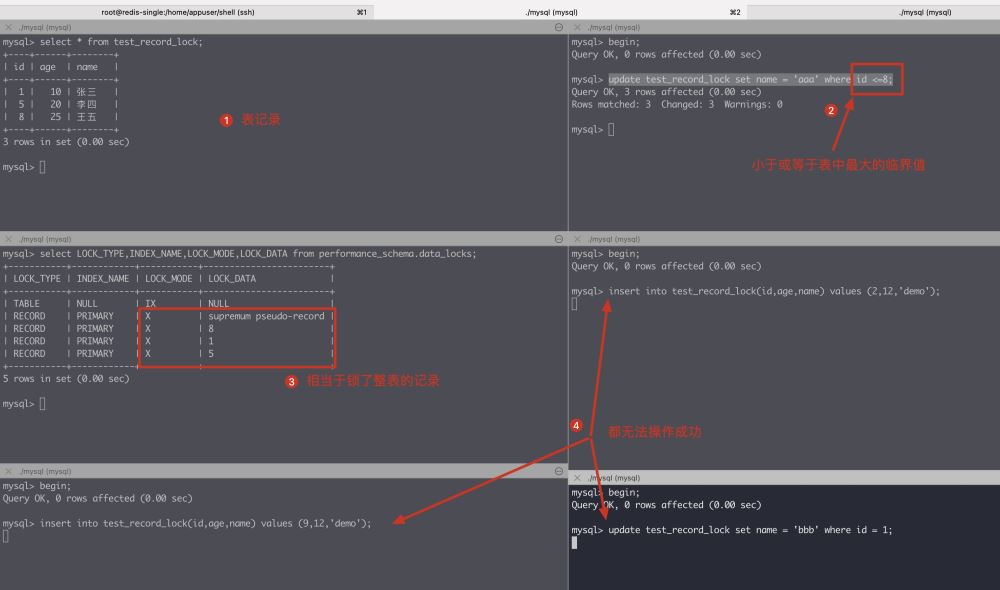
此时可以发现表中扫描到的记录都加上了next key lock(锁加在索引上)
2、大于或等于最小临界值
mysql> begin; Query OK, 0 rows affected (0.01 sec) mysql> update test_record_lock set name = 'aaa' where id >= 1; Query OK, 3 rows affected (0.00 sec) Rows matched: 3 Changed: 3 Warnings: 0 mysql> select LOCK_TYPE,INDEX_NAME,LOCK_MODE,LOCK_DATA from performance_schema.data_locks; +-----------+------------+---------------+------------------------+ | LOCK_TYPE | INDEX_NAME | LOCK_MODE | LOCK_DATA | +-----------+------------+---------------+------------------------+ | TABLE | NULL | IX | NULL | | RECORD | PRIMARY | X,REC_NOT_GAP | 1 | | RECORD | PRIMARY | X | supremum pseudo-record | | RECORD | PRIMARY | X | 8 | | RECORD | PRIMARY | X | 5 | +-----------+------------+---------------+------------------------+ 5 rows in set (0.01 sec)
此时只可向表中插入比最小临界值小的记录。
3、正常范围
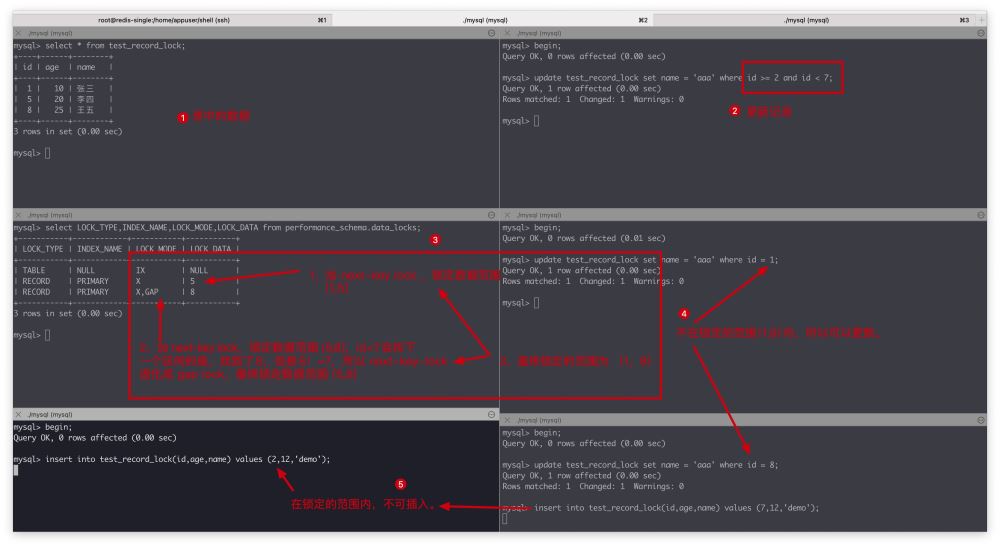
3.2 普通索引测试
3.2.1 等值更新-记录存在
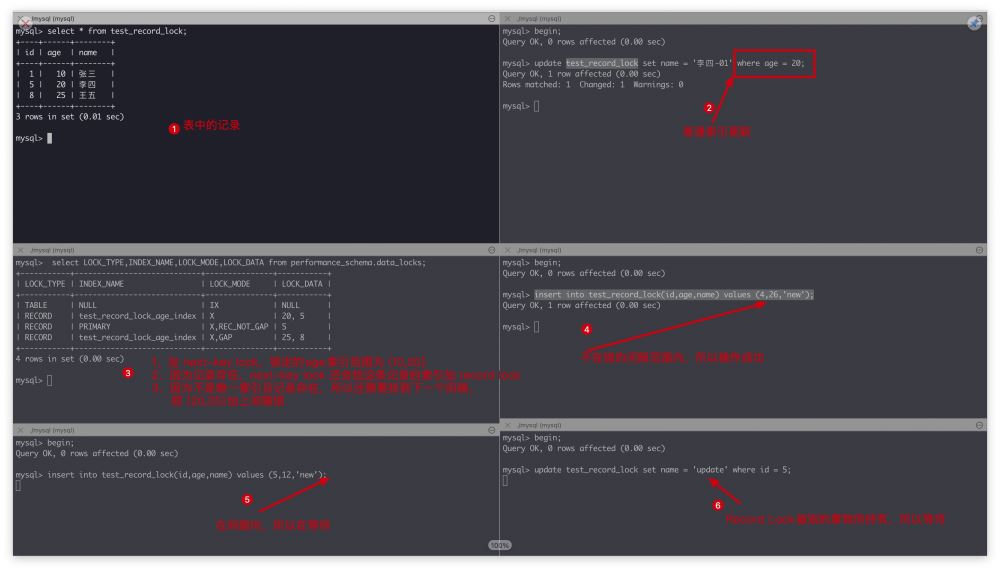
解释:
- 先对普通索引
age加上next-key lock,锁定的范围是(10,20] - next-key lock还会锁住本记录,因此在id索引的值等于5上加了Record Lock
- 因为是普通索引并且值还存在,因此还会对本记录的下一个区间增加间隙锁 Gap Lock,锁定的范围为 (20,25)
3.2.2 等值更新-记录不存在
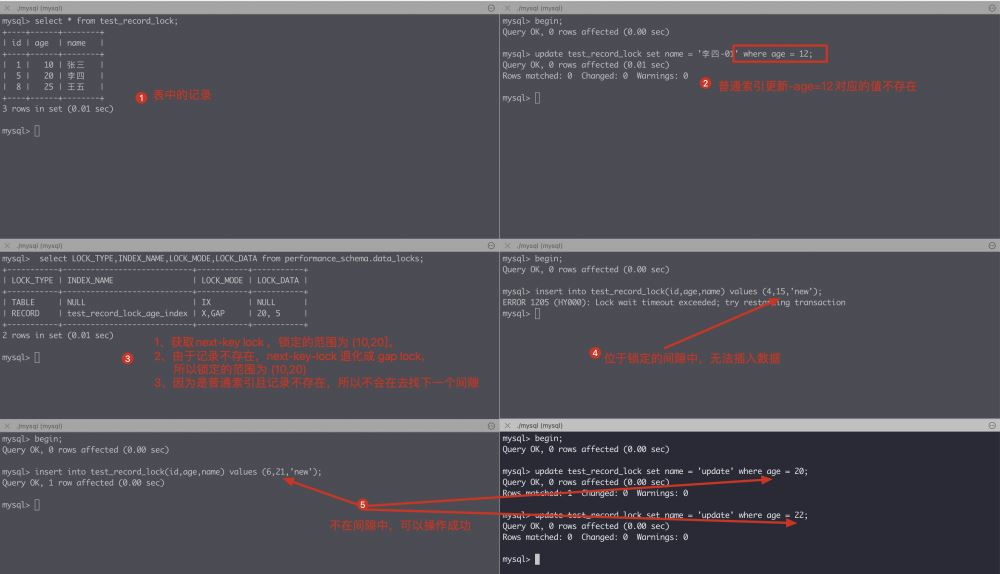
解释:
- 获取next-key lock 锁定的范围为 (10,20]
- 因为需要更新的记录不存在,next-key lock退化成 gap lock,所以锁定的范围为(10,20)
- 因为是普通索引且记录不存在,所以不需要再次查找下一个区间。
3.2.3 范围更新
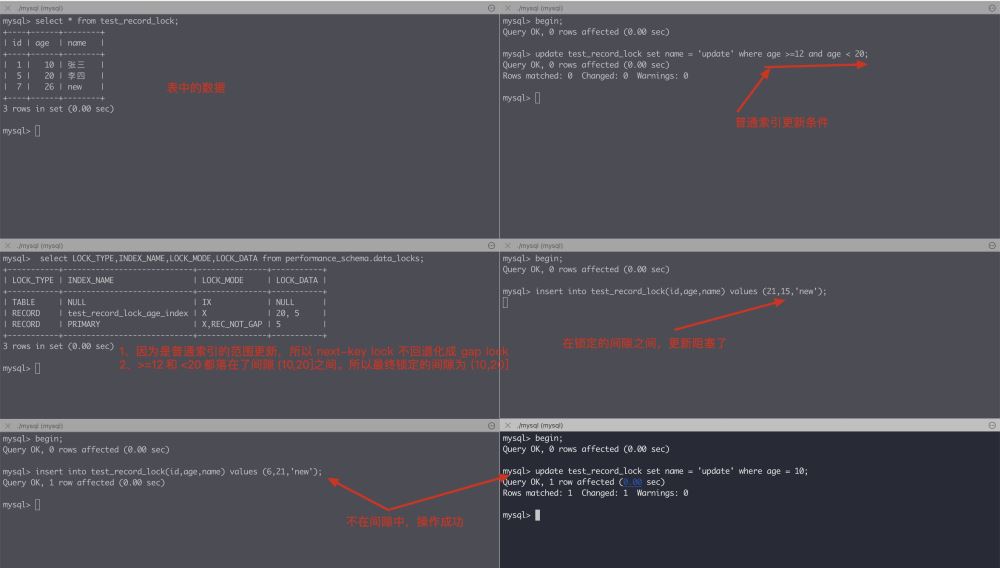
解释:
普通索引的范围更新,next-key-lock不回退化成 gap lock。
3.3 无索引更新
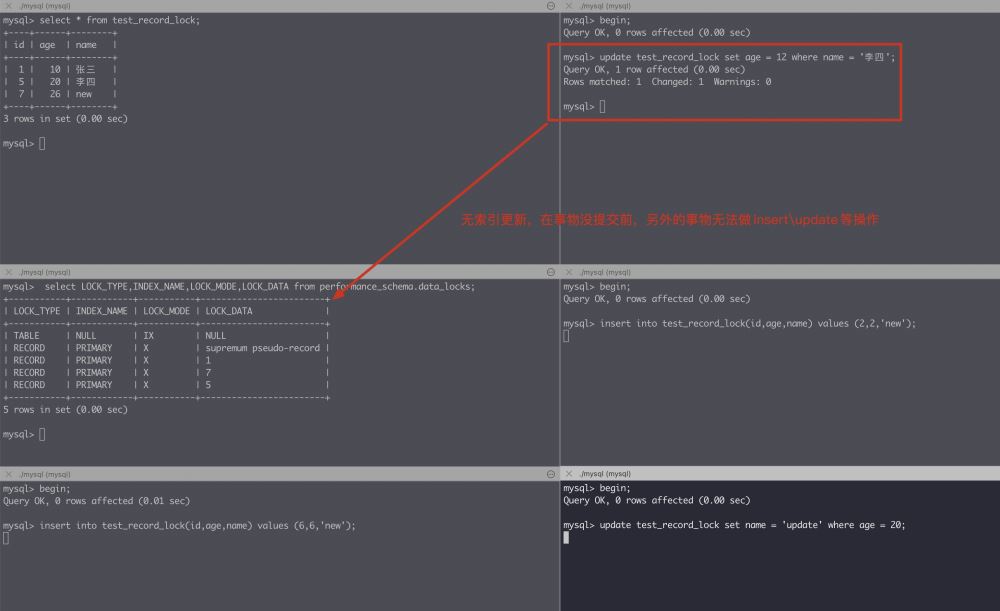
从上图中可知,无索引更新数据表危险,需要谨慎处理。无索引更新,会导致全表扫描,导致将扫描到的所有记录都加上next-key lock。
4、参考链接
1、https://dev.mysql.com/doc/refman/8.0/en/innodb-locking.html
2、https://dev.mysql.com/doc/refman/8.0/en/innodb-locking.html
加载全部内容